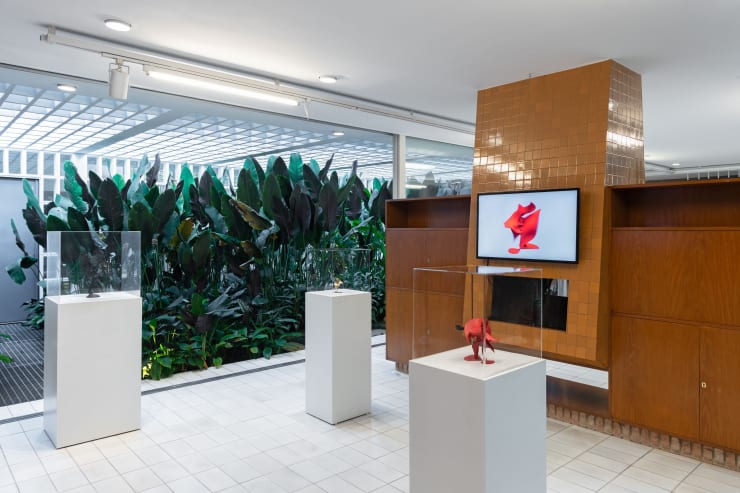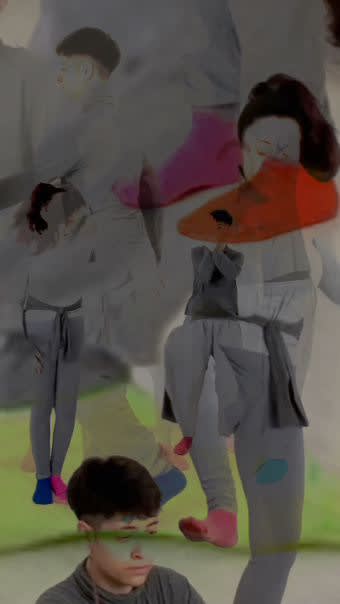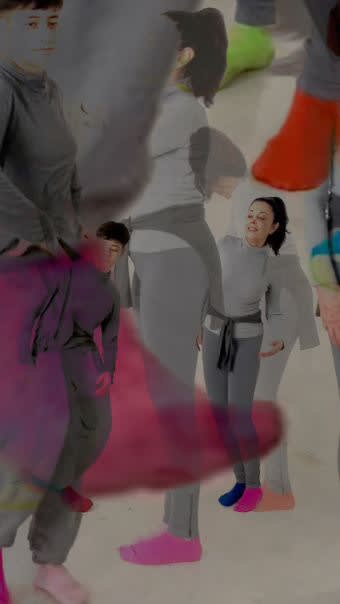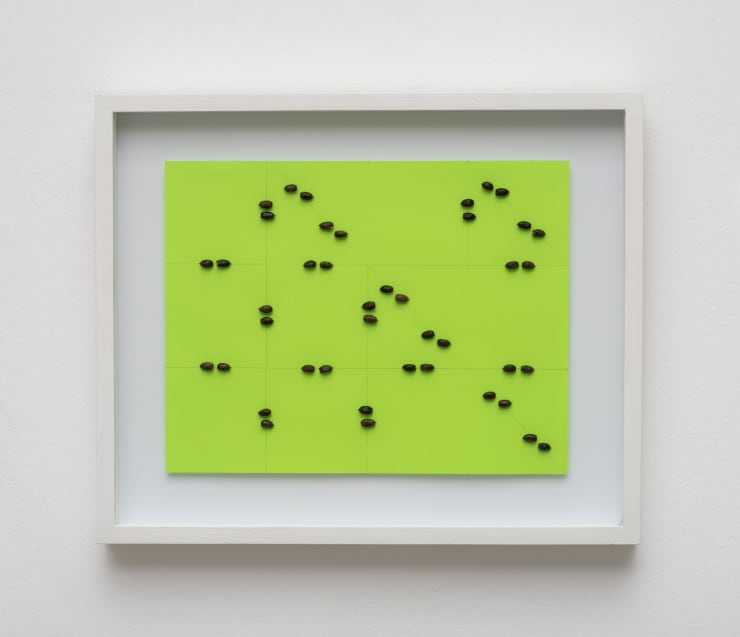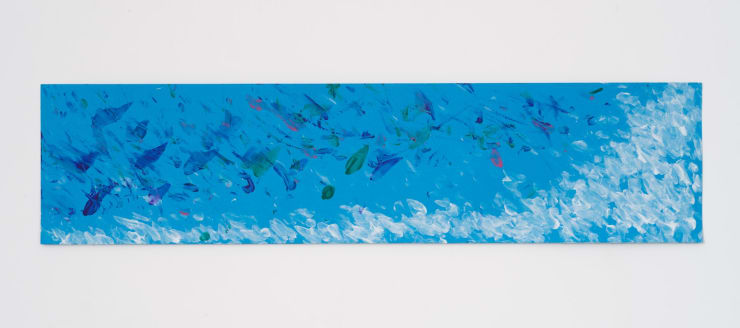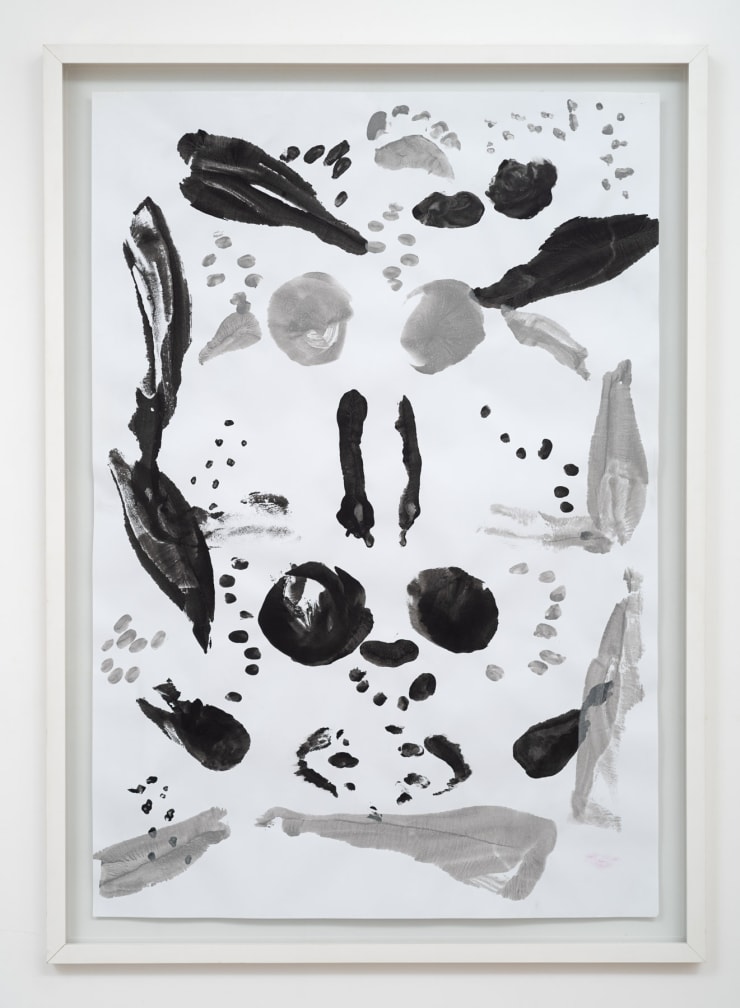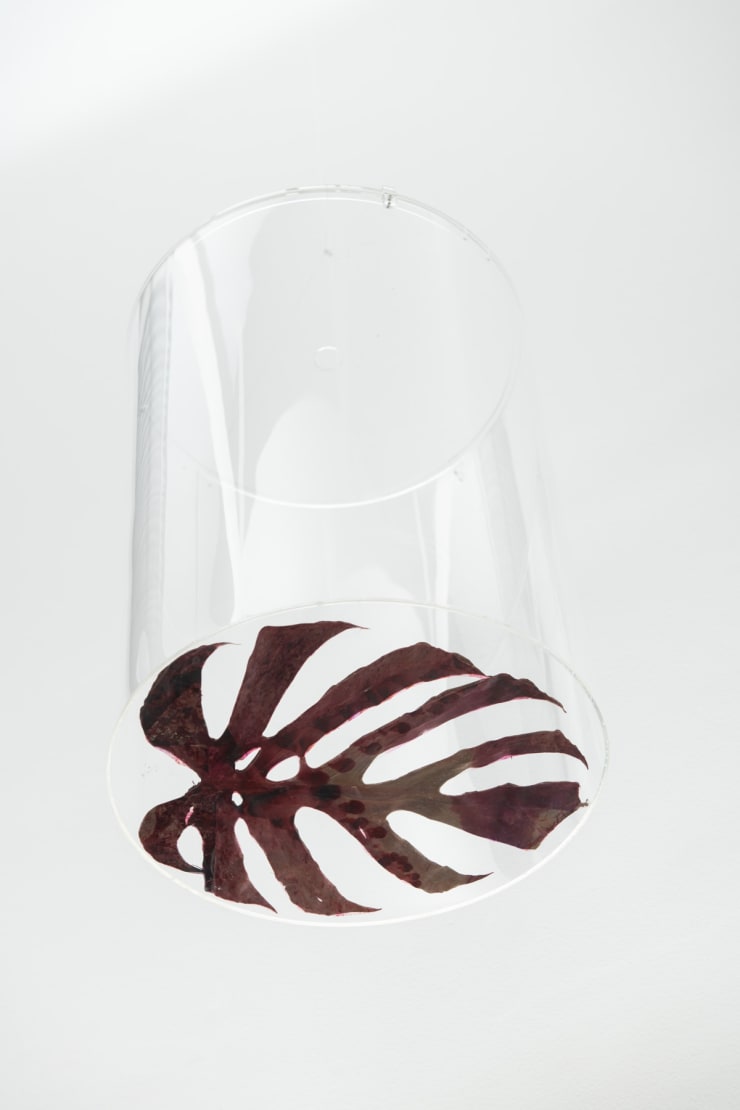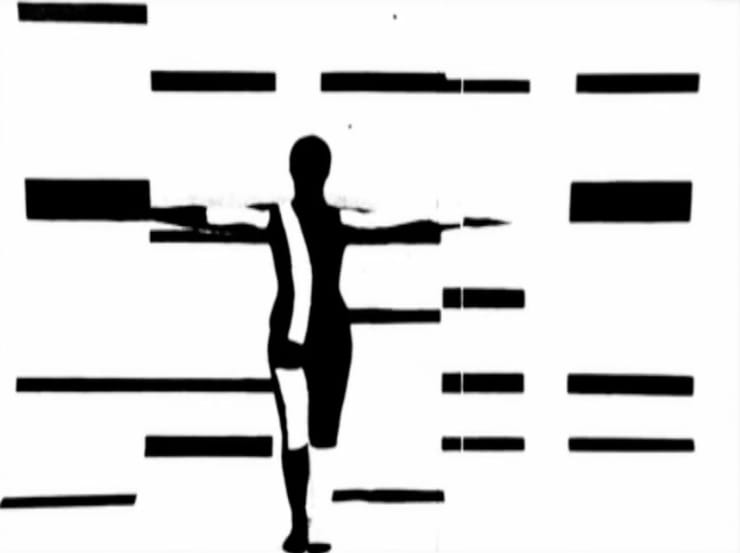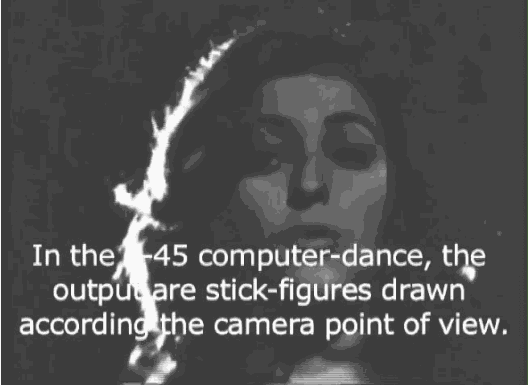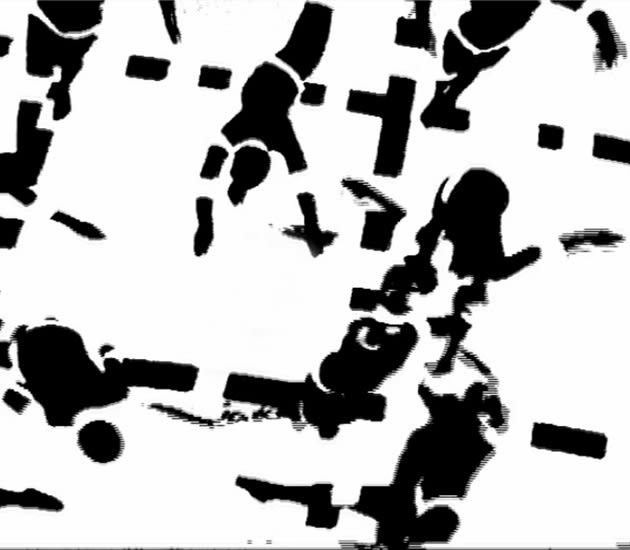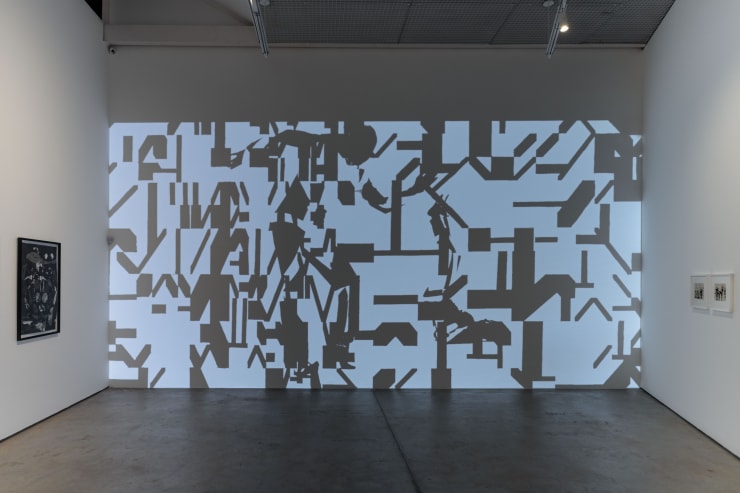Analivia Cordeiro Brazilian
Biography
1954, São Paulo, Brazil. Lives and works in São Paulo, Brazil
Analivia Cordeiro develops her artistic research in a hybrid and multidisciplinary way, with a particular interest in the study of corporal language, focused on various aspects of expression and consciousness, including their relationship with digital media. Her experience with dance began in her childhood and has, ever since, been the central guiding point of her career in the visual arts. A pioneer in the so-called computer dance field and multimedia performance, the artist began to use the computer as a tool for understanding artistic processes as early as 1973, when she became Brazil’s first video artist with the work M3X3, which already foresaw the representativity of information technology in the everyday life of society. In 1981, she created the Nota-Anna software, an application for transcribing the body’s motion, resulting in scientific analyses for the tracing of corporal movements. Analivia’s investigation works with the organic/artificial duality in body language and, in parallel, the control/freedom duality in its relationship with technology, considering corporal language as a semantic filter for reality, an intermediary for dialogue with the public. This has led to her innovative productions in both art and technology, which kindle multisensorial experiences and also work with health, affectivity and self-knowledge , dialoguing with technology, art, the body and the mind.
Analivia Cordeiro holds a BA in architecture from the Faculdade de Arquitetura e Urbanismo of USP (1976, São Paulo), an MA in multimedia from Unicamp (1996, Campinas-SP) and a PhD in communication and semiotics from PUC (2004, São Paulo-SP); she has furthermore done postdoctoral work for the Universidade Federal do Rio de Janeiro (UFRJ, 2010, Rio de Janeiro) and for the Universidade de São Paulo (USP, 2018, São Paulo). Between 1977 and 1979 she studied contemporary dance and choreography at Merce Cunningham Dance Studio in New York and at Alwin Nikolais Studio. Recently, the artist featured her first major solo international exhibition, at the ZKM - Museum of Contemporary Art (2023, Germany) and Centro Atlántico de Arte Moderno, Las Palmas (2023, Spain), besides participating in a show at LACMA (2023, USA). The shows and events in which she has participated notably include the 1973 International Festival of Edinburgh; the 12th Bienal de São Paulo (1974, São Paulo, Brazil); LatinAmerica 74, at Institute of Contemporary Arts (1974, London, GB); International Conference Computer & Humanities/2, at the University of Southern California (1976, Los Angeles, USA); Art of Space Era, at Von Braun Civic Center of Huntsville Museum of Art, 1978; Brasil Século XX, Bienal de São Paulo (1984, Brazil); Arte e Tecnologia, at Itaú Cultural (1996, São Paulo, Brazil); the 27th Annual Dance on Camera Festival (1998, New York, USA); SIGGRAPH (2008, USA), B3 Biennale of Moving Images – Expanded Senses, at Museum Angewandte Kunst (2015, Frankfurt, Germany); Video art in Latin America, Laxart (2016–2017, Los Angeles); Radical Women: Latin American Art, 1960–1985, at Hammer Museum (2017, Los Angeles, USA), Brooklyn Museum (2018, New York, USA) and the Pinacoteca de São Paulo (2023 and 2018, São Paulo, Brazil); Coder le Monde, at Centre Georges Pompidou (2018, Paris, France); and Control and Chance: Art in the Age of Computer, at Victoria & Albert Museum (2018, London, GB). Her work figures in important collections, including those of the Museum of Fine Art, Houston (USA), Victoria & Albert Museum Collection (GB), the Museum of Modern Art of New York (MoMA-NY, USA), the Museo Nacional Centro de Arte Reina Sofia (Spain), the Museum of Concrete Art (Ingolstadt, Germany), MAC-USP (Brazil), the Pinacoteca do Estado de São Paulo (Brazil), Itaú Cultural (Brazil), and the collection of Oskar Schlemmer (Switzerland/Germany). Among her various activities, the artist is a member of the International Dance Committee (IDC), of UNESCO.
Works
-
 Analivia CordeiroVista da exposição ¨Artifinatural Body¨, 2024Luciana Brito Galeria, São Paulo, BrasilView more details
Analivia CordeiroVista da exposição ¨Artifinatural Body¨, 2024Luciana Brito Galeria, São Paulo, BrasilView more details -
 Analivia CordeiroVista da exposição ¨Artifinatural Body¨ , 2024Luciana Brito Galeria, São Paulo, BrasilView more details
Analivia CordeiroVista da exposição ¨Artifinatural Body¨ , 2024Luciana Brito Galeria, São Paulo, BrasilView more details -
 Analivia CordeiroVista da exposição ¨Artifinatural Body¨ , 2024Luciana Brito Galeria, São Paulo, BrasilView more details
Analivia CordeiroVista da exposição ¨Artifinatural Body¨ , 2024Luciana Brito Galeria, São Paulo, BrasilView more details -
 Analivia CordeiroVista da exposição ¨Artifinatural Body¨, 2024Luciana Brito Galeria, São Paulo, BrasilView more details
Analivia CordeiroVista da exposição ¨Artifinatural Body¨, 2024Luciana Brito Galeria, São Paulo, BrasilView more details -
 Analivia CordeiroVista da exposição ¨Artifinatural Body¨ , 2024Luciana Brito Galeria, São Paulo, BrasilView more details
Analivia CordeiroVista da exposição ¨Artifinatural Body¨ , 2024Luciana Brito Galeria, São Paulo, BrasilView more details -
 Analivia CordeiroSmall Talk”, in association with Gissauro, 2022frame de vídeo impresso sobre metal
Analivia CordeiroSmall Talk”, in association with Gissauro, 2022frame de vídeo impresso sobre metal
video frame printed on metal21,5 x 12 cm
8.46 x 4.72 in1/5 + 3 P.A.View more details -
 Analivia Cordeiro“Small Talk”, in association with Gissauro, 2022frame de vídeo impresso sobre metal
Analivia Cordeiro“Small Talk”, in association with Gissauro, 2022frame de vídeo impresso sobre metal
video frame printed on metal21,5 x 12 cm
8.46 x 4.72 in1/5 + 3 P.A.View more details -
 Analivia CordeiroRe-construtivo I, 2020papel, cola e sementes naturais secas
Analivia CordeiroRe-construtivo I, 2020papel, cola e sementes naturais secas
paper, glue and dried natural seeds21,6 x 28 cm
8.5 x 11.02 inView more details -
 Analivia CordeiroRe-construtivo II, 2020papel, cola e sementes naturais secas
Analivia CordeiroRe-construtivo II, 2020papel, cola e sementes naturais secas
paper, glue and dried natural seeds21,6 x 28 cm
8.5 x 11.02 inView more details -
 Analivia CordeiroRe-construtivo III, 2020papel, cola e sementes naturais secas
Analivia CordeiroRe-construtivo III, 2020papel, cola e sementes naturais secas
paper, glue and dried natural seeds21,6 x 28 cm
8.5 x 11.02 inView more details -
 Analivia CordeiroRe-construtivo IV, 2020papel, cola e sementes naturais secas
Analivia CordeiroRe-construtivo IV, 2020papel, cola e sementes naturais secas
paper, glue and dried natural seeds21,6 x 28 cm
8.5 x 11.02 inView more details -
 Analivia CordeiroRe-construtivo V, 2020papel, cola e sementes naturais secas
Analivia CordeiroRe-construtivo V, 2020papel, cola e sementes naturais secas
paper, glue and dried natural seeds21,6 x 28 cm
8.5 x 11.02 inView more details -
 Analivia CordeiroRe-construtivo VI, 2020papel, cola e sementes naturais secas
Analivia CordeiroRe-construtivo VI, 2020papel, cola e sementes naturais secas
paper, glue and dried natural seeds21,6 x 28 cm
8.5 x 11.02 inView more details -
 Analivia CordeiroRe-construtivo VII, 2020papel, cola e sementes naturais secas
Analivia CordeiroRe-construtivo VII, 2020papel, cola e sementes naturais secas
paper, glue and dried natural seeds21,6 x 28 cm
8.5 x 11.02 inView more details -
 Analivia CordeiroRe-construtivo VIII, 2020papel, cola e sementes naturais secas
Analivia CordeiroRe-construtivo VIII, 2020papel, cola e sementes naturais secas
paper, glue and dried natural seeds21,6 x 28 cm
8.5 x 11.02 inView more details -
 Analivia Cordeiro“Re-construtivo”, 2020vídeo digital monocanal, colorido, com som
Analivia Cordeiro“Re-construtivo”, 2020vídeo digital monocanal, colorido, com som
single channel digital video, color, soundduração: 4’12”
duration: 4’12”1/5 + 3 P.A.View more details -
 Analivia Cordeiro“Mutatio: impossible to control just contribute”, 2018;/2021impressão a laser sobre papel
Analivia Cordeiro“Mutatio: impossible to control just contribute”, 2018;/2021impressão a laser sobre papel
laser printing on paper21 x 29,7 cm
8.27 x 11.69 inView more details -
 Analivia Cordeiro“Mutatio: impossible to control just contribute”, 2018/2021impressão a laser sobre papel
Analivia Cordeiro“Mutatio: impossible to control just contribute”, 2018/2021impressão a laser sobre papel
laser printing on paper21 x 29,7 cm
8.27 x 11.69 inView more details -
 Analivia Cordeiro“Mutatio: impossible to control just contribute”, 2018/2021impressão a laser sobre papel
Analivia Cordeiro“Mutatio: impossible to control just contribute”, 2018/2021impressão a laser sobre papel
laser printing on paper21 x 29,7 cm
8.27 x 11.69 cmView more details -
 Analivia Cordeiro"Fingertips I" da série "Dancing on the Paper", 2018guache sobre papel
Analivia Cordeiro"Fingertips I" da série "Dancing on the Paper", 2018guache sobre papel
gouache on paper17 x 71 cm
6.69 x 27.95 inView more details -
 Analivia Cordeiro"Fingertips II" da série "Dancing on the Paper", 2018guache sobre papel
Analivia Cordeiro"Fingertips II" da série "Dancing on the Paper", 2018guache sobre papel
gouache on paper17 x 71 cm
6.69 x 27.95 inView more details -
 Analivia Cordeiro"Fingertips III" da série "Dancing on the Paper", 2018guache sobre papel
Analivia Cordeiro"Fingertips III" da série "Dancing on the Paper", 2018guache sobre papel
gouache on paper17 x 71 cm
6.69 x 27.95 inView more details -
 Analivia Cordeiro"Hair Brush I" da série "Dancing on the Paper", 2018guache sobre papel de arroz
Analivia Cordeiro"Hair Brush I" da série "Dancing on the Paper", 2018guache sobre papel de arroz
gouache on rice paper46 x 109 cm
18.11 x 42.91 inView more details -
 Analivia Cordeiro“Bodyprints II” da série "Dancing on the Paper", 2018guache sobre papel
Analivia Cordeiro“Bodyprints II” da série "Dancing on the Paper", 2018guache sobre papel
gouache on paper96 x 66 cm
37.79 x 25.98 inView more details -
 Analivia Cordeiro“Bodyprints I” da série "Dancing on the Paper", 2018guache sobre papel
Analivia Cordeiro“Bodyprints I” da série "Dancing on the Paper", 2018guache sobre papel
gouache on paper96 x 66 cm
37.79 x 25.98 inView more details -
 Analivia Cordeiro"8s" da série "Dancing on the Paper", 2017guache sobre papel
Analivia Cordeiro"8s" da série "Dancing on the Paper", 2017guache sobre papel
gouache on paper44 x 39 cm (4 partes de 21 x 14,5 cm cada)
17.32 x 15.35 in (4 pieces of 8.27 x 5.71 in each)View more details -
 Analivia Cordeiro"8s" da série "Dancing on the Paper', 2017guache sobre papel
Analivia Cordeiro"8s" da série "Dancing on the Paper', 2017guache sobre papel
gouache on paper96 x 66 cm
37.79 x 25.98 inView more details -
 Analivia Cordeiro"8s" da série "Dancing on the Paper', 2017guache sobre papel
Analivia Cordeiro"8s" da série "Dancing on the Paper', 2017guache sobre papel
gouache on paper39,5 x 47 cm (4 partes de 14,5 x 21 cm cada)
15.55 x 18.5 in (4 pieces of 5.71 x 8.27 in each)View more details -
 Analivia Cordeiro“(In)visible Moving I”, 2017poliamida vermelha
Analivia Cordeiro“(In)visible Moving I”, 2017poliamida vermelha
red polyamide15 x 12,84 x 16,99 cm
5,90 x 7,42 x 6,69 inView more details -
 Analivia Cordeiro“Gold Kick”, 2016latão banhado a ouro
Analivia Cordeiro“Gold Kick”, 2016latão banhado a ouro
gold plated brass13 x 6,5 x 8,5 cm
5.12 x 2.56 x 3.35 inView more details -
 Analivia Cordeiro“Materialization of Sight I”, 2015poliamida
Analivia Cordeiro“Materialization of Sight I”, 2015poliamida
polyamide24,05 x 16,04 x 7,96 cm
9.47 x 6.31 x 3.13 inView more details -
 Analivia Cordeiro“Homo Habilis II”, 2006acetato, guache, caneta hidrográfica, jornal e papel
Analivia Cordeiro“Homo Habilis II”, 2006acetato, guache, caneta hidrográfica, jornal e papel
acetate, gouache, felt-tip pen, newspaper and paper75 x 40 cm
30 x 15.75 inView more details -
 Analivia Cordeiro“Slow Billie Scan”, in association with Lali Krotoszynski, 1987vídeo analógico monocanal, colorido, com som
Analivia Cordeiro“Slow Billie Scan”, in association with Lali Krotoszynski, 1987vídeo analógico monocanal, colorido, com som
single channel analog video, color, sound
duração: 4’05’’
duration: 4’05’’
View more details -
 Analivia Cordeiro“0°‹—›45° versão III”, 1976/2015vídeo monocanal PAL ou NTSC
Analivia Cordeiro“0°‹—›45° versão III”, 1976/2015vídeo monocanal PAL ou NTSC
single video PAL or NTSCduração: 1’52”
duration: 1'52''View more details -
 Analivia Cordeiro¨Cambiantes Original Without Restoration¨, 1976vídeo, 1 canal, PAL ou NTSC
Analivia Cordeiro¨Cambiantes Original Without Restoration¨, 1976vídeo, 1 canal, PAL ou NTSC
single video, PAL or NTSCduração: 4’58”
duration: 4’58”View more details -
 Analivia CordeiroFolhas I, 1975/2014impressão sobre acetato e folha seca
Analivia CordeiroFolhas I, 1975/2014impressão sobre acetato e folha seca
print on acetate and dry sheet30 Ø x 81 cm
11.81 Ø x 31.89 inView more details -
 Analivia CordeiroFolhas II, 1975/2014impressão sobre acetato e folha seca
Analivia CordeiroFolhas II, 1975/2014impressão sobre acetato e folha seca
print on acetate and dry sheet30,5 Ø x 72 cm
12.01 Ø x 28.35 inView more details -
 Analivia CordeiroFolhas III, 1975/2014impressão sobre acetato e folha seca
Analivia CordeiroFolhas III, 1975/2014impressão sobre acetato e folha seca
print on acetate and dry sheet26,5 Ø x 62,5 cm
10.43 Ø x 24.61 inView more details -
 Analivia CordeiroFolhas IV, 1975/2014impressão sobre acetato e folha seca
Analivia CordeiroFolhas IV, 1975/2014impressão sobre acetato e folha seca
print on acetate and dry sheet26,5 Ø x 48,5 cm
10.43 Ø x 19.09 inView more details -
 Analivia CordeiroFolhas V, 1975/2014impressão sobre acetato e folha seca
Analivia CordeiroFolhas V, 1975/2014impressão sobre acetato e folha seca
print on acetate and dry sheet48,5 x 35,5 Ø cm
19.09 x 13.98 Ø inView more details -
 Analivia Cordeiro“0°‹—›45° versão V (remake do 0°‹—›45° versão II)”, 1974/2024vídeo digital monocanal em MP4, 2K, P&B, com som
Analivia Cordeiro“0°‹—›45° versão V (remake do 0°‹—›45° versão II)”, 1974/2024vídeo digital monocanal em MP4, 2K, P&B, com som
single channel digital video, MP4, 2K, B&W, soundduração: 1’57’
duration: 1'57''ed 1/8 + 3 P.A.View more details -
 Analivia Cordeiro“0°‹—›45° versão VI”, 1974/2024vídeo digital monocanal em MP4, 2K, P&B, com som
Analivia Cordeiro“0°‹—›45° versão VI”, 1974/2024vídeo digital monocanal em MP4, 2K, P&B, com som
single channel digital video, MP4, 2K, B&W, soundduração: 2’19”
duration: 2’19”View more details -
 Analivia Cordeiro“0°‹—›45° Dance Notation”, 1974/1984impressão sobre papel | printed paper21,5 x 33,2 cm | 8.46 x 13.07 inView more details
Analivia Cordeiro“0°‹—›45° Dance Notation”, 1974/1984impressão sobre papel | printed paper21,5 x 33,2 cm | 8.46 x 13.07 inView more details -
 Analivia Cordeiro0º ‹—› 45º Versão I, 1974vídeo preto e branco 4:3, com som
Analivia Cordeiro0º ‹—› 45º Versão I, 1974vídeo preto e branco 4:3, com som
black and white video 4:3, with soundduração: 3’23”
duration: 3’23”ed 4/8 + 3 P.A.
View more details -
 Analivia CordeiroEstudos de cena e figurino para "0°‹—›45° versão I", 1974lápis de cor sobre papel
Analivia CordeiroEstudos de cena e figurino para "0°‹—›45° versão I", 1974lápis de cor sobre papel
colored pencil on paperView more details -
 Analivia CordeiroStatement, 1974single video PAL or NTSCduration: 01'20"Min. Edition 8 + 3AP
Analivia CordeiroStatement, 1974single video PAL or NTSCduration: 01'20"Min. Edition 8 + 3AP
Ed.-Nr.: 1/8View more details -
 Analivia Cordeiro¨Statement¨, 1974vídeo monocanal PAL ou NTSC, formato 4:3
Analivia Cordeiro¨Statement¨, 1974vídeo monocanal PAL ou NTSC, formato 4:3
duração: 1‘20¨
duration: 1‘20¨View more details -
 Analivia Cordeiro¨M3x3¨, 1973vídeo monocanal, PAL ou NTSC
Analivia Cordeiro¨M3x3¨, 1973vídeo monocanal, PAL ou NTSC
single video, PAL or NTSCduração: 9’53”
duration: 9’53”View more details -
 Analivia Cordeiro¨M3x3¨ , 1973vídeo monocanal, PAL ou NTSC
Analivia Cordeiro¨M3x3¨ , 1973vídeo monocanal, PAL ou NTSC
single video, PAL or NTSCduração: 9’53”
duration: 9’53”View more details
Exhibitions
-

Analivia Cordeiro | Artifinatural Body
curated by Franck James Marlot 18 May - 20 July 2024Presenting Analivia Cordeiro's work for the first time at Galeria Luciana Brito is a real challenge. Her protean work spans several artistic fields, including dance, performance, computer art, ethnography and...Read more -

Analivia Cordeiro, bianca turner e Selva de Carvalho | Fauna, Flora e Primavera
Curated by Fernando Mota 24 September - 15 October 2022“For a long time, we were tricked by the story that we are humanity. During that time – while the wolf doesn’t come – we became more alienated from this...Read more -

LB/Online Video Festival
28 April 2020 - 3 April 2021On this Friday, December 11, we have finalized the selection of works for the Online Video Festival. The idea for this festival arose before the pandemic, and it is being...Read more

